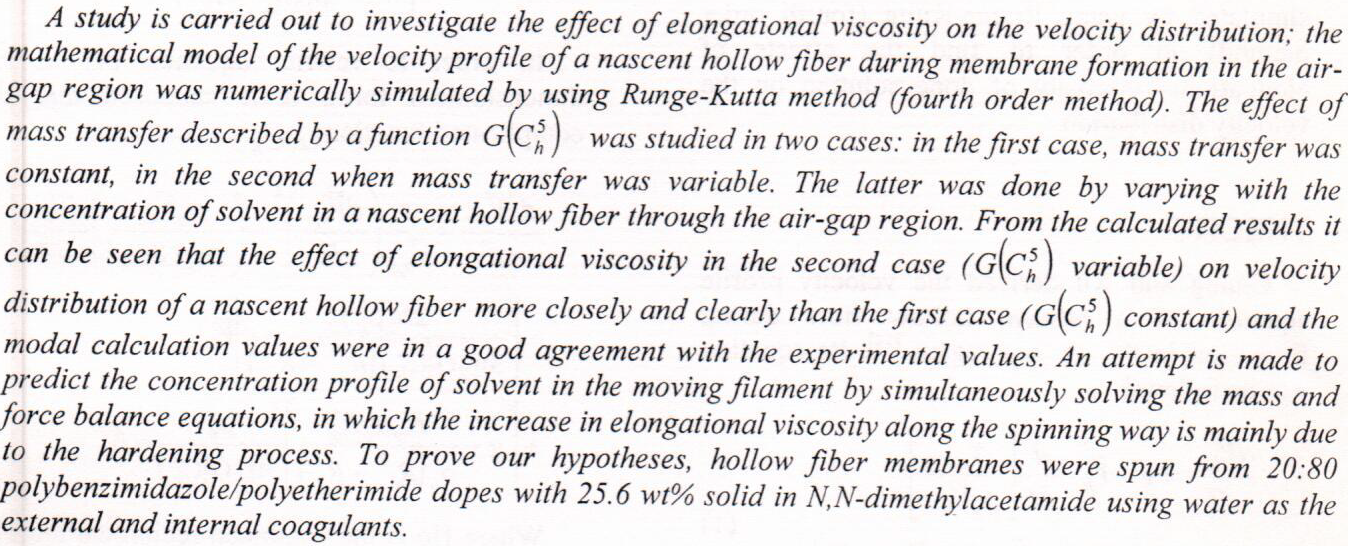
Thermal performance of closed wet cooling tower has been investigated experimentally and theoretically
in this work. The theoretical model based on heat and mass transfer equations and heat and mass transfer balance equations which are established for steady state case. A new small indirect cooling tower was used for conducting experiments. The cooling capacity of cooling tower is 1 kW for an inlet water temperature of 38oC, a water mass velocity 2.3 kg/m2.s and an air wet bulb temperature of 26oC. This study investigates the relationship between saturation efficiency, cooling capacity and coefficient of performance of closed wet cooling tower versus different operating parameters such wet-bulb temperature, variable air-spray water fl
In this study two types of extraction solvents were used to extract the undesirable polyaromatics, the first solvent was furfural which was used today in the Iraqi refineries and the second was NMP (N-methyl-2-pyrrolidone).
The studied effecting variables of extraction are extraction temperature ranged from 70 to 110°C and solvent to oil ratio in the range from 1:1 to 4:1.
The results of this investigation show that the viscosity index of mixed-medium lubricating oil fraction increases with increasing extraction temperature and reaches 107.82 for NMP extraction at extraction temperature 110°C and solvent to oil ratio 4:1, while the viscosity index reaches to 101 for furfural extraction at the same extraction temperature and same
A polycrystalline PbxS1-x alloys with various Pb content ( 0.54 and 0.55) has been prepared successfully. The structure and composition of alloys are determined by X-ray diffraction (XRD), atomic absorption spectroscopy (AAS) and X-ray fluorescence (XRF) respectively. The X-ray diffraction results shows that the structure is polycrystalline with cubic structure, and there are strong peaks at the direction (200) and (111), the grain size varies between 20 and 82 nm. From AAS and XRF result, the concentrations of Pb content for these alloys were determined. The results show high accuracy and very close to the theoretical values. A photoconductive detector as a bulk has been fabricated by taking pieces of prepared alloys and polished chemic
... Show More (7)
(7)
 (7)
(7)
Background: This study aimed to evaluate the effect addition of polyester fibers on the some mechanical properties of heat cured acrylic resin (implant strength, flexural strength and hardness) Materials and methods: Ninety specimens were used in the study. Thirty specimens were used for impact strength measurements (80mm X 10mm X 4mm) length, width and thickness respectively. The specimens divided into three test groups (n=10), first group formed from heat cure acrylic resin without fiber reinforcement. Second group was formed from heat cure acrylic resin was reinforced with 2 mm length polyester fiber and third group was formed from heat cure acrylic resin reinforced with 4mm length polyester fiber, impact strength measured by impact test
... Show MoreThe effect of fiber volume fraction of the carbon fiber on the thermal conductivity of the polymer composite material was studied. Different percentages of carbon fibers were used (5%, 10%, 15%, 20%, and 25%). Specimens were made in two groups for unsaturated polyester as a matrix and carbon fibers, first group has parallel arrangement of fibers and the second group has perpendicular arrangement of fibers on the thermal flow, Lee's disk method was used for testing the specimens. This study showed that the values of the of thermal conductivity of the specimens when the fibers arranged in parallel direction was higher than that when the fibers arranged in the perpendicular direction
 
... Show MoreAim: surface modification of titanium using fiber laser 1064 nm to enhance the bond strength to resin cement. Material and Methods: thirty titanium discs of 0.6 cm x 0.3 cm (diameter and thickness respectively) were categorized after preparation into three groups (n=10) as follows: control group with no surface treatment and two test groups were treated with fiber laser after estimation the appropriate parameters in the pilot study which are 81 ns pulse duration, 30,000 Hz frequency, 50 µm spot size and 10,000 mm/s scanning speed and different average power values (10 W and 20 W) depending on the tested group. Titanium discs surface characterization was performed by scanning electron microscope (SEM), a
... Show MoreOne of the most important problems in tablet process is to control the flow of the catalyst through the hopper; Controlling the flow can be done either by changing the size of particles or added the different lubricant (stearic acid, starch, graphite) or blending of different lubricants. The study showed that we can control (increase or decrease) on the flow of the catalyst through the hopper by blending different lubricants for the constant percentage. The flow increasing when particles size (0.6 mm) and then decrease with or without lubricants, no effect on flow when particles size lower than (0.2 mm) with use that lubricants, and good flow on (0.4 mm) when use stearic acid and starch.
This study aimed to determine the optimal conditions for extracting basil seed gum in addition to determine the chemical components of basil seeds. Additionally, the study aimed to investigate the effect of the mixing ratio of gum to ethanol when deposited on the basis of the gum yield which was1:1, 1:2, 1:3 (v/v) respectively. The best mixing ratio was one size of gum to two sizes of ethanol, which recorded the highest yield. Based on the earlier, the optimal conditions for extracting basil seed gum in different levels which included pH, temperature, mixing ratio seeds: water and the soaking duration were studied. The optimal conditions were: pH 8, temperature of 60°C, mixing ratio seeds: water 1:65 (w/v) and soaking duration of 30 min
... Show More